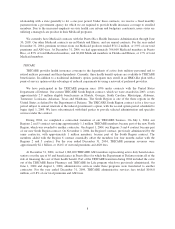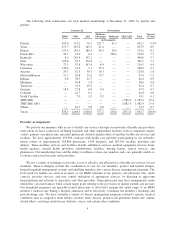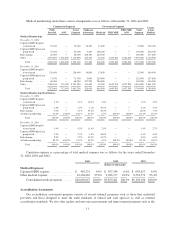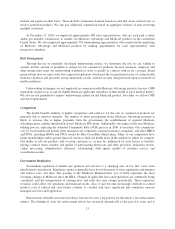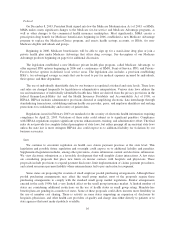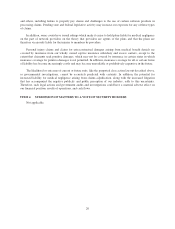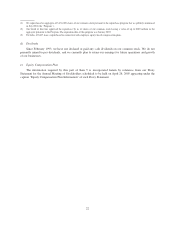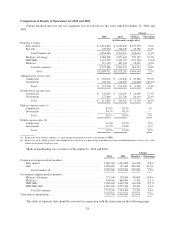Humana 2004 Annual Report Download - page 28
Download and view the complete annual report
Please find page 28 of the 2004 Humana annual report below. You can navigate through the pages in the report by either clicking on the pages listed below, or by using the keyword search tool below to find specific information within the annual report.
We also own or lease administrative market offices and medical centers. We no longer operate most of these
medical centers but, rather, lease them to their provider operators. The following table lists the location of
properties we owned or leased at December 31, 2004:
Medical Centers
Administrative
Offices
Owned Leased Owned Leased Total
Florida ....................................... 1 38 6 48 93
Texas ........................................ — — 3 30 33
Kentucky ..................................... 2 — 12 6 20
Georgia ...................................... — — — 17 17
Illinois ....................................... 7 1 — 5 13
Puerto Rico ................................... — — — 11 11
Louisiana ..................................... — — — 9 9
Tennessee .................................... — — — 7 7
Alabama ..................................... — — — 6 6
Ohio ......................................... — — — 6 6
Wisconsin .................................... — — 1 5 6
Others ....................................... 1 1 — 43 45
Total .................................... 11 40 22 193 266
ITEM 3. LEGAL PROCEEDINGS
Managed Care Industry Purported Class Action Litigation
We have been involved in several purported class action lawsuits that are part of a wave of generally similar
actions that target the health care payer industry and particularly target managed care companies. These include a
lawsuit against us and originally nine of our competitors that purports to be brought on behalf of physicians who
have treated our members. As a result of action by the Judicial Panel on Multidistrict Litigation (“JPML”), the
case was consolidated in the United States District Court for the Southern District of Florida, and has been styled
In re Managed Care Litigation.
The plaintiffs assert that we and other defendants improperly paid providers’ claims and “downcoded” their
claims by paying lesser amounts than they submitted. The complaint alleges, among other things, multiple
violations under the Racketeer Influenced and Corrupt Organizations Act, or RICO, as well as various breaches
of contract and violations of regulations governing the timeliness of claim payments. The complaint was
subsequently amended to add as plaintiffs several medical societies, including the Texas Medical Association,
the Medical Association of Georgia, the California Medical Association, the Florida Medical Association, and
the Louisiana State Medical Society, each of which purports to bring its action against specified defendants.
On September 26, 2002, the Court certified a global class consisting of all medical doctors who provided
services to any person insured by any defendant from August 4, 1990, to September 26, 2002. The class included
two subclasses. A national subclass consisted of medical doctors who provided services to any person insured by
a defendant when the doctor had a claim against such defendant and was not required to arbitrate that claim. A
California subclass consisted of medical doctors who provided services to any person insured in California by
any defendant when the doctor was not bound to arbitrate the claim.
On September 1, 2004, the Court of Appeals for the Eleventh Circuit (“Eleventh Circuit”) agreed with the
District Court’s ruling as to the class for the RICO claims, although it suggested that the class should be split so
that claims involving capitation and fee-for-service payments would be handled separately. However, it reversed
the lower court as to state law claims, including breach of contract, unjust enrichment and violations of prompt
pay laws. It found that the state claims were too individualized to be dealt with in a class action. The California
subclass was not specifically challenged and therefore was permitted to remain. On October 15, 2004, the
defendants filed a Petition for a Writ of Certiorari to the United States Supreme Court, asking for review of the
Eleventh Circuit’s decision. The petition was denied on January 10, 2005.
18


